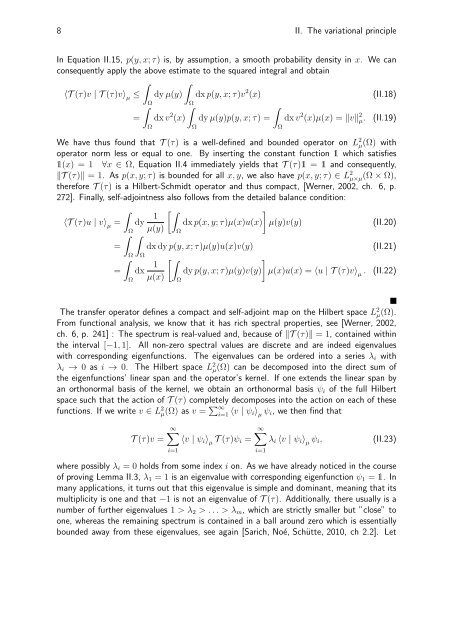Variational Principles in Conformation Dynamics - FU Berlin, FB MI
Variational Principles in Conformation Dynamics - FU Berlin, FB MI
Variational Principles in Conformation Dynamics - FU Berlin, FB MI
- No tags were found...
You also want an ePaper? Increase the reach of your titles
YUMPU automatically turns print PDFs into web optimized ePapers that Google loves.
8 II. The variational pr<strong>in</strong>cipleIn Equation II.15, p(y, x; τ) is, by assumption, a smooth probability density <strong>in</strong> x. We canconsequently apply the above estimate to the squared <strong>in</strong>tegral and obta<strong>in</strong> T (τ)v |T(τ)v µ≤ dy µ(y) dx p(y, x; τ)v 2 (x)(II.18)ΩΩ= dx v 2 (x) dy µ(y)p(y, x; τ) = dx v 2 (x)µ(x) =v 2 µ. (II.19)ΩΩWe have thus found that T (τ) is a well-def<strong>in</strong>ed and bounded operator on L 2 µ(Ω) withoperator norm less or equal to one. By <strong>in</strong>sert<strong>in</strong>g the constant function 1 which satisfies1(x) =1 ∀x ∈ Ω, Equation II.4 immediately yields that T (τ)1 = 1 and consequently,T (τ) =1. As p(x, y; τ) is bounded for all x, y, wealsohavep(x, y; τ) ∈ L 2 µ×µ(Ω × Ω),therefore T (τ) is a Hilbert-Schmidt operator and thus compact, [Werner, 2002, ch. 6,p.272]. F<strong>in</strong>ally, self-adjo<strong>in</strong>tness also follows from the detailed balance condition:T (τ)u | v µ= dy 1 dx p(x, y; τ)µ(x)u(x) µ(y)v(y)(II.20)Ω µ(y) Ω = dx dy p(y, x; τ)µ(y)u(x)v(y)(II.21)Ω Ω= dx 1 dy p(y, x; τ)µ(y)v(y) µ(x)u(x) =u |T(τ)vΩ µ(x)µ. (II.22)ΩΩThe transfer operator def<strong>in</strong>es a compact and self-adjo<strong>in</strong>t map on the Hilbert space L 2 µ(Ω).From functional analysis, we know that it has rich spectral properties, see [Werner, 2002,ch. 6, p. 241] : The spectrum is real-valued and, because of T (τ) =1,conta<strong>in</strong>edwith<strong>in</strong>the <strong>in</strong>terval [−1, 1]. All non-zero spectral values are discrete and are <strong>in</strong>deed eigenvalueswith correspond<strong>in</strong>g eigenfunctions. The eigenvalues can be ordered <strong>in</strong>to a series λ i withλ i → 0 as i → 0. The Hilbert space L 2 µ(Ω) can be decomposed <strong>in</strong>to the direct sum ofthe eigenfunctions’ l<strong>in</strong>ear span and the operator’s kernel. If one extends the l<strong>in</strong>ear span byan orthonormal basis of the kernel, we obta<strong>in</strong> an orthonormal basis ψ i of the full Hilbertspace such that the action of T (τ) completely decomposes <strong>in</strong>to the action on each of thesefunctions. If we write v ∈ L 2 µ(Ω) as v = ∞i=1 v | ψ i µψ i ,wethenf<strong>in</strong>dthatT (τ)v =∞v | ψ i µT (τ)ψ i =i=1∞λ i v | ψ i µψ i ,i=1(II.23)where possibly λ i =0holds from some <strong>in</strong>dex i on. As we have already noticed <strong>in</strong> the courseof prov<strong>in</strong>g Lemma II.3, λ 1 =1is an eigenvalue with correspond<strong>in</strong>g eigenfunction ψ 1 = 1. Inmany applications, it turns out that this eigenvalue is simple and dom<strong>in</strong>ant, mean<strong>in</strong>g that itsmultiplicity is one and that −1 is not an eigenvalue of T (τ). Additionally, there usually is anumber of further eigenvalues 1 >λ 2 >...>λ m ,whicharestrictlysmallerbut”close”toone, whereas the rema<strong>in</strong><strong>in</strong>g spectrum is conta<strong>in</strong>ed <strong>in</strong> a ball around zero which is essentiallybounded away from these eigenvalues, see aga<strong>in</strong> [Sarich, Noé, Schütte, 2010, ch2.2]. Let









